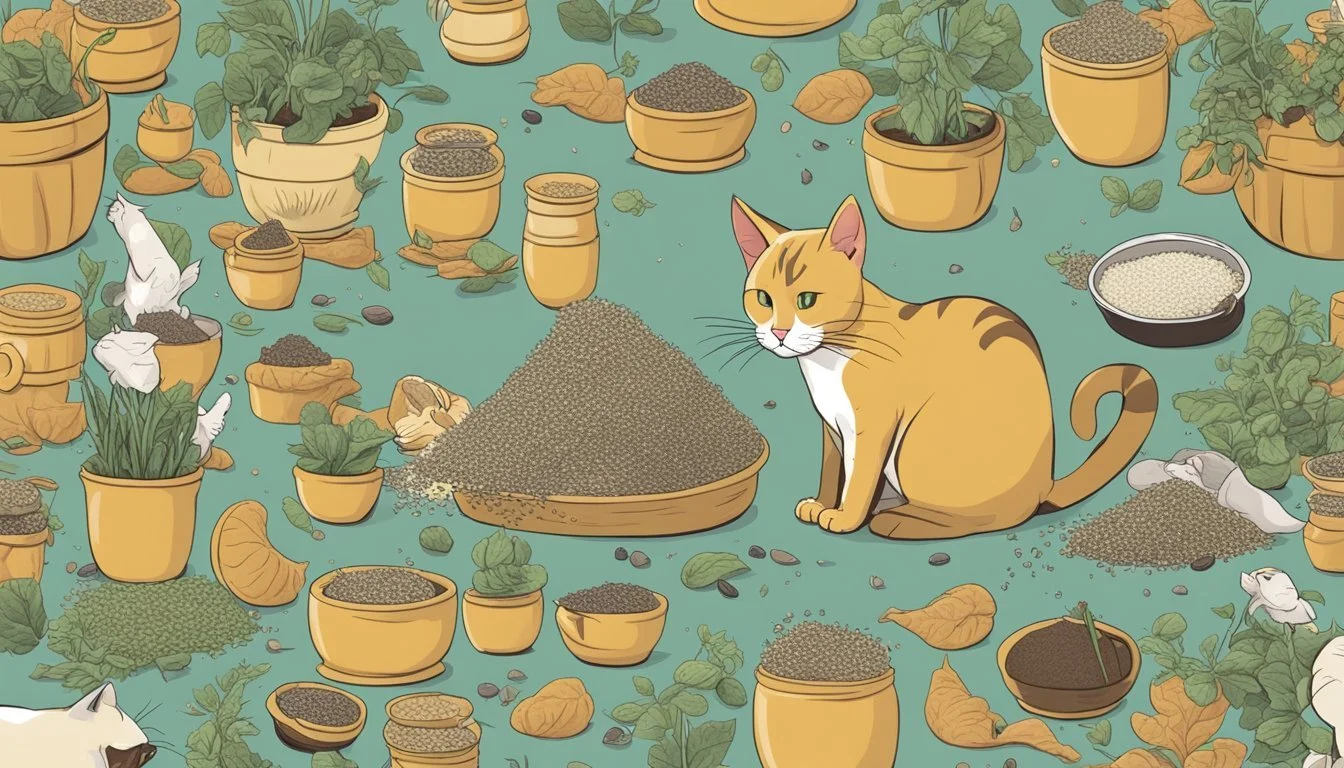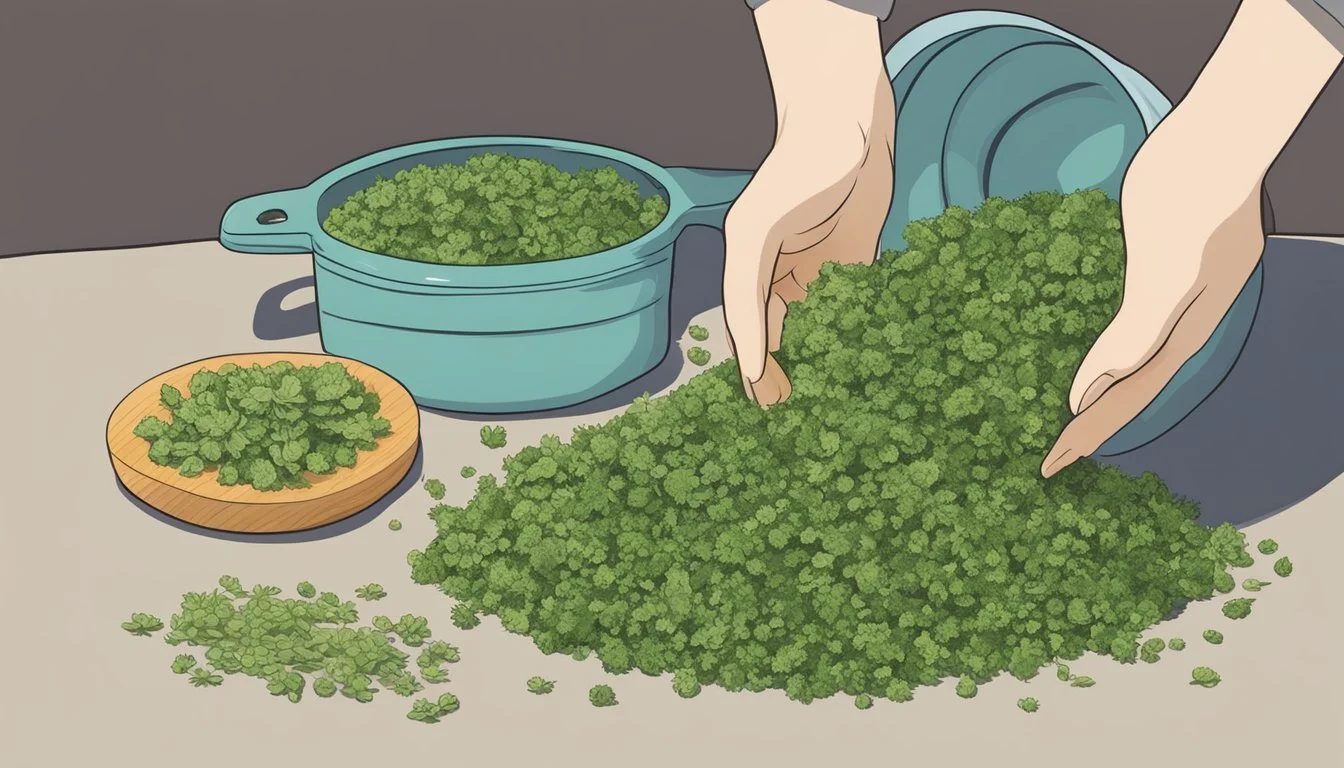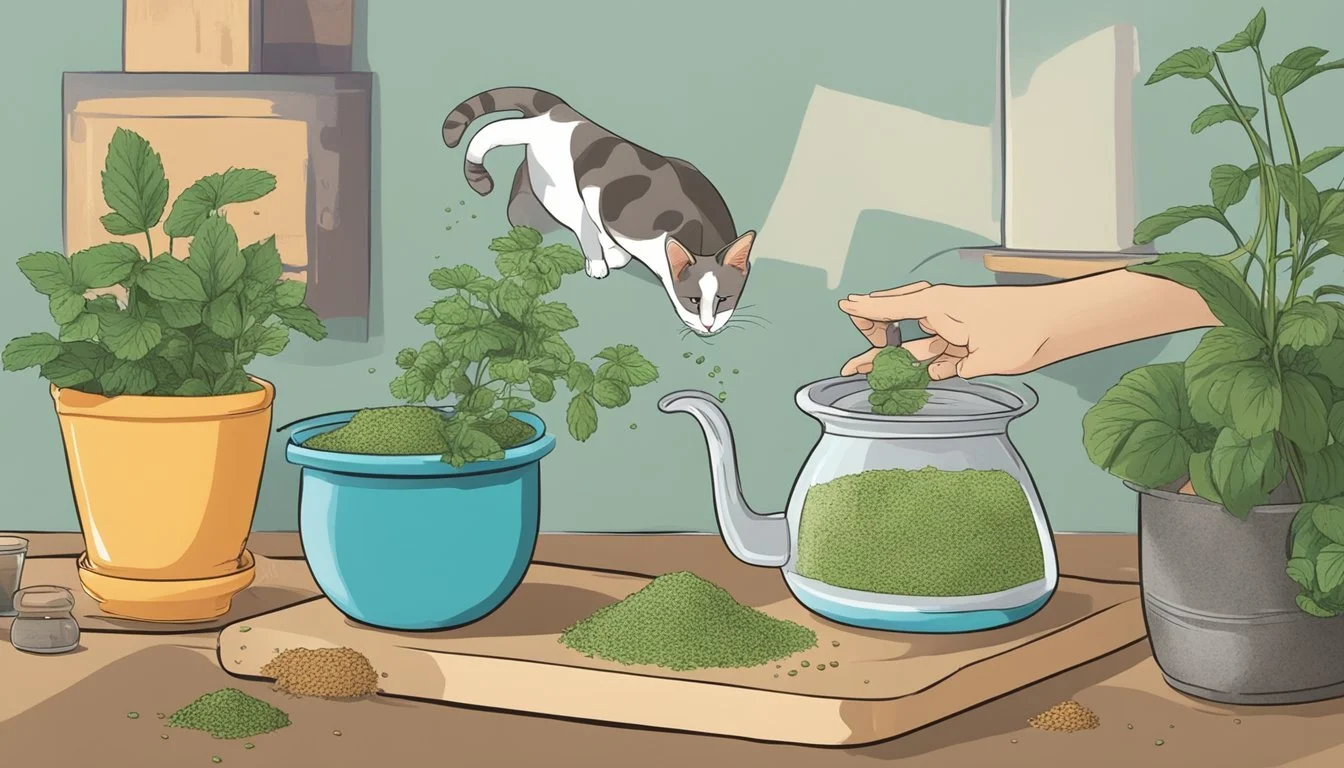Catnip Seeds Substitutes
Effective Alternatives for Your Garden
Catnip, scientifically known as Nepeta cataria, is a perennial herb from the mint family, native to Europe and Asia. It’s well-known for its captivating effect on many felines. Growing catnip from seeds is relatively easy and can be a fun project for cat owners. However, some cats don’t respond to catnip, leading many to seek alternative plants that can provide similar enjoyment.
One popular substitute is Silvervine, a plant native to Russia, Japan, and China. Another choice is Cat Thyme, which similarly induces feelings of contentment and happiness in cats. These alternatives might offer a stronger or different kind of reaction than traditional catnip, making them excellent options for diversifying the sensory experiences of your feline friends.
Understanding Catnip
Catnip, botanically known as Nepeta cataria, is a perennial herb from the mint family. It emits a distinctive aroma, thanks to the compound nepetalactone, which is known to drive cats wild.
Botanical Profile
Nepeta cataria, commonly known as catnip, is a perennial flowering plant from the mint family. It boasts heart-shaped leaves with serrated edges, and its stems are typically covered with fine hairs. This plant produces clusters of small white, pink, or purple flowers that are fragrant. The aroma, primarily due to nepetalactone found in the leaves and stems, attracts cats and pollinators alike.
Catnip grows to a height of about 50-100 cm (20-40 inches) and prefers well-drained soil and full sunlight. It is hardy in many climates and often found in gardens where its aromatic leaves and pretty flowers add both beauty and function.
Benefits and Uses
The primary benefit of catnip is its effect on cats. When cats smell nepetalactone, it triggers a burst of playful energy, often seen as rolling, flipping, or rubbing against the plant. This makes it a popular choice for cat toys and treats.
Humans can also use catnip. The dried leaves and flowers can be brewed into a calming tea, which is said to help with anxiety and insomnia. Catnip's essential oil, derived from the plant, is sometimes used in natural insect repellents, especially against mosquitoes.
Additionally, in the garden, catnip attracts beneficial pollinators such as bees, aiding in the ecosystem's health. Its versatility makes it a valuable herb in various applications.
Varieties of Catnip
There are several Nepeta species and varieties, including common catnip (Nepeta cataria) and catmint (Nepeta mussinii). While Nepeta cataria is most famous for its effect on cats, other varieties also provide similar benefits but may differ in appearance and growing requirements.
Catmint, for instance, tends to have bluer flowers and a slightly different scent. It is often used more for ornamental purposes in gardens due to its attractive flowering. Some varieties are less attractive to cats, making them a good choice for gardeners who want the benefits without the feline attention.
Each variety of catnip has its unique characteristics but shares the common trait of being part of the Nepeta genus, offering both aesthetic and practical benefits.
Propagation of Catnip
Catnip can be propagated through various methods, including seed sowing and stem cuttings. Understanding the essential techniques ensures successful growth and healthy plants.
Seed Selection and Preparation
Selecting quality catnip seeds is crucial for healthy plants. Purchase seeds from reputable suppliers or harvest them from mature catnip plants. Once the seeds are obtained, prepare them through stratification.
Stratification involves placing the seeds in a freezer overnight, which enhances the germination. After freezing, soak the seeds in water for 24 hours to further increase the germination rate. This process ensures the seeds are ready for planting, providing a higher success rate for growth.
Planting Techniques
When planting catnip seeds, use well-draining soil. Sow the seeds in rows, approximately one-quarter-inch deep. Keeping the soil moist during this period is vital.
Place the seed trays in a warm area around 70°F (21°C) to foster germination. The seeds generally germinate within 10-14 days. After germination, thin the seedlings to prevent overcrowding, allowing each plant enough space to grow.
Transplant the seedlings to the planting site once they are strong enough. Ensure proper spacing for healthy growth, typically around 12-18 inches apart. This method promotes vigorous and healthy catnip plants.
Cultivating Catnip
Growing catnip involves understanding its preferred conditions and providing the necessary care to ensure healthy and productive plants.
Optimal Growing Conditions
Catnip thrives best in full sun but can tolerate partial shade. It prefers well-drained soil with a neutral to slightly acidic pH. Planting seeds in the late winter or early spring is ideal as it aligns with the plant's natural growth cycle. Germination occurs faster in temperatures around 70 degrees Fahrenheit.
For successful cultivation, sow the seeds thinly and cover them lightly with soil. Keep the soil consistently moist during the germination period, which typically lasts 7-10 days. Ensuring adequate sunlight and proper water drainage will help the seedlings sprout vigorously.
Caring for Catnip Plants
Once established, catnip requires minimal maintenance. Regular watering is essential, particularly during dry spells. Although resistant to most pests, catnip can be susceptible to aphids and spider mites. Employ organic sprays if infestations occur.
Fertilizing is rarely necessary, but an annual application of compost can promote bushy growth. Harvesting frequently prevents the plant from becoming invasive. Cutting back the plant encourages more compact growth and prevents early seeding. Be watchful for fungal diseases, especially in humid conditions, and ensure good air circulation to mitigate this risk.
Harvesting and Preservation
Proper harvesting and preservation of catnip are essential to maintain its benefits. Timing the harvest and using correct drying methods ensures that the plant retains its potent oils.
Harvesting Catnip Leaves and Flowers
Catnip should be harvested when its flowers are in full bloom, typically in the summer. This is when the plant's oils are most concentrated. Shear the stems around mid-morning after the dew has evaporated but before the heat of the day. Use sharp scissors or pruning shears to make clean cuts, preventing damage to the plant.
Harvest the top third of the plant, ensuring you have a mix of leaves and flowering tops. Avoid cutting too close to the base to promote regrowth for future harvests. Having multiple cuttings throughout the growing season can maximize yield.
Drying and Storing Catnip
Drying catnip properly is critical for preserving its oils. Spread the harvested catnip stalks in a well-ventilated area away from direct sunlight. A dark, airy room or a greenhouse with good air circulation works best.
To speed up drying, you can use a dehydrator set to low heat, but ensure not to overdry, as it can degrade quality. It usually takes one to two weeks for the catnip to dry completely. Check periodically for dryness by feeling the stems; they should be brittle.
Once dry, store the catnip in airtight containers like mason jars. Label the containers with the drying date and store them in a cool, dark place. For long-term storage, consider freezing the dried catnip in vacuum-sealed bags to maintain freshness without the risk of mold. Avoid plastic bags for long-term storage, as they can cause condensation.
Troubleshooting Common Issues
When growing catnip seed substitutes, common issues include managing pests and diseases and addressing environmental stress factors. These challenges can impact plant health and overall success.
Managing Pests and Diseases
Catnip seed substitutes often attract a variety of pests that can damage plants. Aphids and spider mites are especially troublesome. Aphids suck plant juices, causing leaves to yellow and curl. Spider mites lead to speckled leaves and fine webbing. Routine inspection helps in early detection.
For pest control, insecticidal soap is often effective. Neem oil can also deter pests without harming plants. Keep plants well-spaced to ensure airflow and reduce pest opportunities. Diseases like root rot occur with poor drainage. Ensure soil remains well-draining to prevent waterlogging.
Proper watering techniques are crucial. Overwatering should be avoided to minimize root rot risks. If plants show signs of disease, removing affected parts can prevent spread. Regularly cleaning tools and hands reduces contamination risks.
Environmental Stress Factors
Environmental stress can drastically impact catnip seeds substitutes. Adequate sunlight is crucial; these plants thrive with at least six hours of sun daily. Inadequate light causes leggy growth and poor vigor. Temperature and humidity also play vital roles in plant health.
Catnip prefers hardiness zones 3-9 with moderate temperatures. Extreme heat or cold requires protective measures like mulching or shading. Humidity levels should be balanced to avoid fungal diseases while preventing dryness that stresses plants.
Soil quality influences plant resilience. Well-draining, fertile soil promotes healthy growth. Amending soil with organic matter improves structure and nutrient content. Regularly testing soil pH ensures it remains within optimal ranges for catnip substitutes. Implementing these measures helps mitigate environmental stress and fosters robust plant development.
Catnip in Garden Design
Catnip is a versatile addition to garden designs, offering both functional and aesthetic benefits. By carefully integrating it into landscapes and using it in companion planting, gardeners can enhance the beauty and productivity of their spaces.
Incorporating Catnip into Landscapes
Catnip can be a valuable asset to landscapes, adding texture and fragrance. Its gray-green foliage and delicate flowers blend well with other plants.
Placement: Choose spots with well-drained soil and full sun to partial shade. This ensures optimal growth and longevity.
Spacing: Leave about 18-24 inches between plants to allow for their bushy growth. Proper spacing aids in air circulation, reducing the risk of disease.
Design: Catnip can be used along borders, in rock gardens, or as ground cover. It attracts pollinators like bees and butterflies, contributing to a lively garden atmosphere.
Companion Planting
Catnip works well in companion planting, naturally deterring pests and benefiting neighboring plants.
Pest Control: Catnip repels aphids and squash bugs. Planting it near beans, cucumbers, and pumpkins can reduce pest infestations.
Herb Gardens: In an herb garden, catnip complements basil, oregano, and thyme. It helps in maintaining a healthy garden bed by deterring harmful insects.
Compost and Mulch: Use compost to enrich the soil where catnip grows. Mulch helps retain moisture and regulate soil temperature.
Support: Catnip plants may need staking to keep them upright, especially in windy areas. Stakes ensure the plant remains healthy and aesthetically pleasing.
By following these guidelines, catnip can be a practical and ornamental element in any garden design.
Growing Catnip Indoors and Containers
Growing catnip indoors offers many advantages. It's especially beneficial for those without garden space. Indoor growing allows control over conditions such as light and temperature.
Containers are vital for indoor catnip. Choose containers at least 8 inches wide by 8 inches deep. This size provides ample room for roots to spread.
Catnip belongs to the mint family and can spread aggressively. Using containers helps contain this spread. Container gardening also makes it easier to move plants as needed to optimize sunlight exposure.
Planting
Plant catnip seeds in seed-starting containers. Sow the seeds lightly and cover them with a thin layer of soil, about 1/4 inch. Place the containers in a sunny spot, such as a windowsill, to receive adequate light.
Watering and Care
Keep the soil lightly moist but not soggy. Overwatering can lead to root rot. Use drainage holes in containers to prevent water build-up.
Regular pruning helps maintain the plant's shape and encourages new growth. By keeping plants trimmed, you also prevent them from becoming leggy.
Light Requirements
Catnip thrives in sunlight. Aim for at least 6 hours of direct sunlight daily. If natural light is insufficient, consider using a grow light to supplement.
Advantages of indoor catnip:
Controlled environment
Easy sunlight management
Less pest exposure
Limitations:
May lack potency compared to outdoor catnip
Regular maintenance required
Materials Needed:
Seed-starting containers or pots
Quality potting soil
Watering can
Pruning shears
Growers who follow these tips will find success with indoor catnip cultivation.







